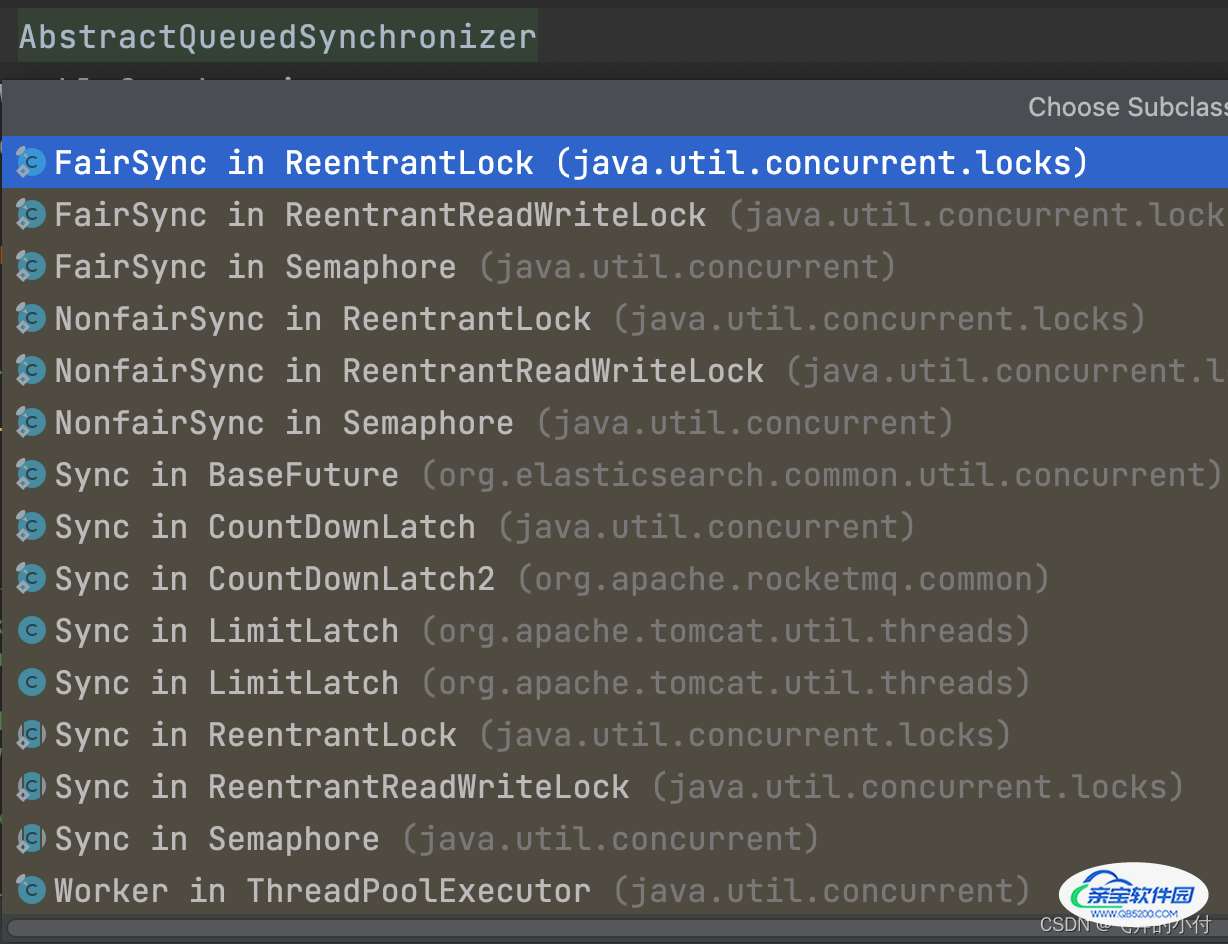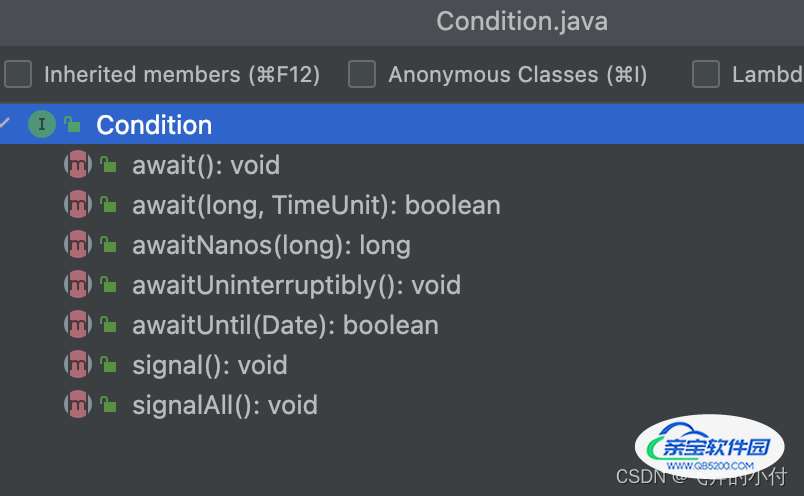Java AQS中ReentrantLock条件锁的使用
飞奔的小付 人气:0一.什么是AQS
1.定义
java.util.concurrent包中的大多数同步器实现都是围绕着共同的基础行为,比如等待队列、条件队列、独占获取、共享获取等,而这些行为的抽象就是基于AbstractQueuedSynchronizer(简称AQS)实现的,AQS是一个抽象同步框架,可以用来实现一个依赖状态的同步器。
JDK中提供的大多数的同步器如Lock, Latch, Barrier等,都是基于AQS框架来实现的。

- 一般都是通过一个内部类sync继承AQS
- 将同步器所有调用都同步到Sync对应的方法
2.特性
- 阻塞等待队列
- 共享/独占
- 公平/非公平
- 可重入
- 允许中断
3.属性
内部维护属性volatile int state,表示资源的可用状态
- getState()
- setState()
- compareAndSetState()
4.资源共享方式
- Exclusive-独占,只有一个线程能执行,如ReentrantLock
- Share-共享,多个线程可以同时执行,如Semaphore/CountDownLatch
5.两种队列
- 同步等待队列: 主要用于维护获取锁失败时入队的线程
- 条件等待队列: 调用await()的时候会释放锁,然后线程会加入到条件队列,调用signal()唤醒的时候会把条件队列中的线程节点移动到同步队列中,等待再次获得锁
6.队列节点状态
- 值为0,初始化状态,表示当前节点在sync队列中,等待着获取锁。
- CANCELLED,值为1,表示当前的线程被取消;
- SIGNAL,值为-1,表示当前节点的后继节点包含的线程需要运行,也就是unpark;
- CONDITION,值为-2,表示当前节点在等待condition,也就是在condition队列中;
- PROPAGATE,值为-3,表示当前场景下后续的acquireShared能够得以执行;
7.实现方法
自定义同步器实现时主要实现以下几种方法:
- isHeldExclusively():该线程是否正在独占资源。只有用到condition才需要去实现它。
- tryAcquire(int):独占方式。尝试获取资源,成功则返回true,失败则返回false。
- tryRelease(int):独占方式。尝试释放资源,成功则返回true,失败则返回false。
- tryAcquireShared(int):共享方式。尝试获取资源。负数表示失败;0表示成功,但没有剩余可用资源;正数表示成功,且有剩余资源。
- tryReleaseShared(int):共享方式。尝试释放资源,如果释放后允许唤醒后续等待结点返回true,否则返回false。
二.等待队列
1.同步等待队列
AQS当中的同步等待队列也称CLH队列,CLH队列是Craig、Landin、Hagersten三人发明的一种基于双向链表数据结构的队列,是FIFO先进先出线程等待队列,Java中的CLH队列是原CLH队列的一个变种,线程由原自旋机制改为阻塞机制。
AQS 依赖CLH同步队列来完成同步状态的管理:
- 当前线程如果获取同步状态失败时,AQS则会将当前线程已经等待状态等信息构造成一个节点(Node)并将其加入到CLH同步队列,同时会阻塞当前线程
- 当同步状态释放时,会把首节点唤醒(公平锁),使其再次尝试获取同步状态。
- 通过signal或signalAll将条件队列中的节点转移到同步队列。(由条件队列转化为同步队列)
2.条件等待队列
AQS中条件队列是使用单向列表保存的,用nextWaiter来连接:
- 调用await方法阻塞线程;
- 当前线程存在于同步队列的头结点,调用await方法进行阻塞(从同步队列转化到条件队列)
三.condition接口

- 调用Condition#await方法会释放当前持有的锁,然后阻塞当前线程,同时向Condition队列尾部添加一个节点,所以调用Condition#await方法的时候必须持有锁。
- 调用Condition#signal方法会将Condition队列的首节点移动到阻塞队列尾部,然后唤醒因调用Condition#await方法而阻塞的线程(唤醒之后这个线程就可以去竞争锁了),所以调用Condition#signal方法的时候必须持有锁,持有锁的线程唤醒被因调用Condition#await方法而阻塞的线程。
public static void main(String[] args) {
Lock lock = new ReentrantLock();
Condition condition = lock.newCondition();
new Thread(() -> {
lock.lock();
try {
log.debug(Thread.currentThread().getName() + " 开始处理任务");
//会释放当前持有的锁,然后阻塞当前线程
condition.await();
log.debug(Thread.currentThread().getName() + " 结束处理任务");
} catch (InterruptedException e) {
e.printStackTrace();
} finally {
lock.unlock();
}
}).start();
new Thread(() -> {
lock.lock();
try {
log.debug(Thread.currentThread().getName() + " 开始处理任务");
Thread.sleep(2000);
//唤醒因调用Condition#await方法而阻塞的线程
condition.signal();
log.debug(Thread.currentThread().getName() + " 结束处理任务");
} catch (Exception e) {
e.printStackTrace();
} finally {
lock.unlock();
}
}).start();
}
Thread-0 开始处理任务
Thread-1 开始处理任务
Thread-1 结束处理任务
Thread-0 结束处理任务
四.ReentrantLock
1.ReentrantLock是什么
ReentrantLock是一种基于AQS框架的应用实现,是JDK中的一种线程并发访问的同步手段,它的功能类似于synchronized是一种互斥锁,可以保证线程安全。
2.特点
- 可中断
- 可以设置超时时间
- 可以设置为公平锁
- 支持多个条件变量
- 与 synchronized 一样,都支持可重入
3. ReentrantLock和synchronized的区别
- synchronized是JVM层次的锁实现,ReentrantLock是JDK层次的锁实现;
- synchronized的锁状态是无法在代码中直接判断的,但是ReentrantLock可以通过ReentrantLock#isLocked判断;
- synchronized是非公平锁,ReentrantLock可以是公平也可以是非公平的,默认是非公平的;
- synchronized是不可以被中断的,而ReentrantLock#lockInterruptibly方法是可以被中断的;
- 在发生异常时synchronized会自动释放锁,而ReentrantLock需要开发者在finally块中显示释放锁;
- ReentrantLock获取锁的形式有多种:如立即返回是否成功的tryLock(),以及等待指定时长的获取,更加灵活;
- synchronized在特定的情况下对于已经在等待的线程是后来的线程先获得锁(回顾一下sychronized的唤醒策略),而ReentrantLock对于已经在等待的线程是先来的线程先获得锁;
4. ReentrantLock的使用
伪代码:
ReentrantLock lock = new ReentrantLock(); //参数默认false,不公平锁
ReentrantLock lock = new ReentrantLock(true); //公平锁
//加锁
lock.lock();
try {
//临界区
} finally {
// 解锁
lock.unlock();
例子:基本使用
private static int sum = 0;
private static Lock lock = new ReentrantLock();
public static void main(String[] args) throws InterruptedException {
for (int i = 0; i < 3; i++) {
Thread thread = new Thread(()->{
//加锁 一般写在try前面
lock.lock();
try {
// 临界区代码 业务逻辑
for (int j = 0; j < 10000; j++) {
sum++;
}
} finally {
// 解锁
lock.unlock();
}
});
thread.start();
}
Thread.sleep(2000);
System.out.println(sum);
}
30000
可重入
public static ReentrantLock lock = new ReentrantLock();
public static void main(String[] args) {
method1();
}
public static void method1() {
lock.lock();
try {
log.debug("execute method1");
method2();
} finally {
lock.unlock();
}
}
public static void method2() {
lock.lock();
try {
log.debug("execute method2");
method3();
} finally {
lock.unlock();
}
}
public static void method3() {
lock.lock();
try {
log.debug("execute method3");
} finally {
lock.unlock();
}
}
execute method1
execute method2
execute method3
可中断
public static void main(String[] args) throws InterruptedException {
ReentrantLock lock = new ReentrantLock();
Thread t1 = new Thread(() -> {
log.debug("t1启动...");
try {
lock.lockInterruptibly();
try {
log.debug("t1获得了锁");
} finally {
lock.unlock();
}
} catch (InterruptedException e) {
e.printStackTrace();
log.debug("t1等锁的过程中被中断");
}
}, "t1");
lock.lock();
try {
log.debug("main线程获得了锁");
t1.start();
//先让线程t1执行
Thread.sleep(1000);
t1.interrupt();
log.debug("线程t1执行中断");
} finally {
lock.unlock();
}
}
main线程获得了锁
t1启动…
线程t1执行中断
t1等锁的过程中被中断
锁超时
public static void main(String[] args) throws InterruptedException {
ReentrantLock lock = new ReentrantLock();
Thread t1 = new Thread(() -> {
log.debug("t1启动...");
try {
//if (!lock.tryLock()) {
// log.debug("t1获取锁失败,立即返回false");
// return;
//}
if (!lock.tryLock(1, TimeUnit.SECONDS)) {
log.debug("等待 1s 后获取锁失败,返回");
return;
}
} catch (Exception e) {
e.printStackTrace();
return;
}
try {
log.debug("t1获得了锁");
} finally {
lock.unlock();
}
}, "t1");
lock.lock();
try {
log.debug("main线程获得了锁");
t1.start();
//先让线程t1执行
Thread.sleep(2000);
} finally {
lock.unlock();
}
}
main线程获得了锁
t1启动…
等待 1s 后获取锁失败,返回
公平锁和非公平锁
public static void main(String[] args) throws InterruptedException {
// ReentrantLock lock = new ReentrantLock(true); //公平锁
ReentrantLock lock = new ReentrantLock(); //非公平锁
for (int i = 0; i < 500; i++) {
new Thread(() -> {
lock.lock();
try {
try {
Thread.sleep(10);
} catch (InterruptedException e) {
e.printStackTrace();
}
log.debug(Thread.currentThread().getName() + " running...");
} finally {
lock.unlock();
}
}, "t" + i).start();
}
// 1s 之后去争抢锁
Thread.sleep(1000);
for (int i = 0; i < 500; i++) {
new Thread(() -> {
lock.lock();
try {
log.debug(Thread.currentThread().getName() + " running...");
} finally {
lock.unlock();
}
}, "强行插入" + i).start();
}
}
条件变量
private static ReentrantLock lock = new ReentrantLock();
private static Condition cigCon = lock.newCondition();
private static Condition takeCon = lock.newCondition();
private static boolean hashcig = false;
private static boolean hastakeout = false;
//送烟
public void cigratee(){
lock.lock();
try {
while(!hashcig){
try {
log.debug("没有烟,歇一会");
cigCon.await();
}catch (Exception e){
e.printStackTrace();
}
}
log.debug("有烟了,干活");
}finally {
lock.unlock();
}
}
//送外卖
public void takeout(){
lock.lock();
try {
while(!hastakeout){
try {
log.debug("没有饭,歇一会");
takeCon.await();
}catch (Exception e){
e.printStackTrace();
}
}
log.debug("有饭了,干活");
}finally {
lock.unlock();
}
}
public static void main(String[] args) {
ReentrantLockDemo6 test = new ReentrantLockDemo6();
new Thread(() ->{
test.cigratee();
}).start();
new Thread(() -> {
test.takeout();
}).start();
new Thread(() ->{
lock.lock();
try {
hashcig = true;
log.debug("唤醒送烟的等待线程");
cigCon.signal();
}finally {
lock.unlock();
}
},"t1").start();
new Thread(() ->{
lock.lock();
try {
hastakeout = true;
log.debug("唤醒送饭的等待线程");
takeCon.signal();
}finally {
lock.unlock();
}
},"t2").start();
}
没有烟,歇一会
没有饭,歇一会
唤醒送烟的等待线程
唤醒送饭的等待线程
有烟了,干活
有饭了,干活
五.源码解析
首先会调用lock方法
public void lock() {
sync.lock();
}
lock会调用公平方法或者非公平的方法,默认是非公平锁方法,非公平锁则会cas尝试加锁,state是不是0,是0的话就把它改为1,并设置当前线程为独占线程,加锁成功,待下个线程进来时已经变成1,则失败阻塞。
加锁
final void lock() {
// 看状态是不是0,如果是0 则改为1,加锁成功
if (compareAndSetState(0, 1))
// 并设置当前线程为独占线程
setExclusiveOwnerThread(Thread.currentThread());
else
//不是0则失败阻塞
acquire(1);
}
protected final void setExclusiveOwnerThread(Thread thread) {
exclusiveOwnerThread = thread;
}
加锁失败(入队 阻塞)
public final void acquire(int arg) {
if (!tryAcquire(arg) &&
acquireQueued(addWaiter(Node.EXCLUSIVE), arg))
//恢复中断标识位
selfInterrupt();
}
首先tryAcquire 又进行了一次判断,看是否能获取锁,
final boolean nonfairTryAcquire(int acquires) {
final Thread current = Thread.currentThread();
int c = getState();
//其他线程进来,状态值是1
if (c == 0) {
if (compareAndSetState(0, acquires)) {
setExclusiveOwnerThread(current);
return true;
}
}
else if (current == getExclusiveOwnerThread()) {
// 重入,将状态值+1
int nextc = c + acquires;
if (nextc < 0) // overflow
throw new Error("Maximum lock count exceeded");
setState(nextc);
return true;
}
return false;
}
添加进队列
private Node addWaiter(Node mode) {
Node node = new Node(Thread.currentThread(), mode);
// Try the fast path of enq; backup to full enq on failure
Node pred = tail;
//第一次tail为空
if (pred != null) {
//尾插法
node.prev = pred;
if (compareAndSetTail(pred, node)) {
pred.next = node;
return node;
}
}
//tail为空则在这里创建队列
enq(node);
return node;
}
创建队列并且入队
private Node enq(final Node node) {
for (;;) {
Node t = tail;
if (t == null) { // Must initialize
//创建队列
if (compareAndSetHead(new Node()))
// 将头节点指向前一节点的尾节点,这时候tail不为空了
tail = head;
} else {
//双向接口,前一节点的尾节点也指向当前节点的头节点
node.prev = t;
if (compareAndSetTail(t, node)) {
t.next = node;
return t;
}
}
}
}
阻塞
final boolean acquireQueued(final Node node, int arg) {
boolean failed = true;
try {
boolean interrupted = false;
for (;;) { //保证一定获取锁
//获取head节点
final Node p = node.predecessor();
//是头节点则尝试获取锁
if (p == head && tryAcquire(arg)) {
//设置头节点
setHead(node);
p.next = null; // help GC
failed = false;
return interrupted;
}
//获取锁失败的情况,阻塞,在for循环里,第一次shouldParkAfterFailedAcquire为false,会将其设置为-1,第二次就可以阻塞
if (shouldParkAfterFailedAcquire(p, node) &&
parkAndCheckInterrupt())
interrupted = true;
}
} finally {
if (failed)
cancelAcquire(node);
}
}
是否需要阻塞,把状态设置为SIGNAL,可以被唤醒了
private static boolean shouldParkAfterFailedAcquire(Node pred, Node node) {
int ws = pred.waitStatus;
//是-1了就可以去阻塞
if (ws == Node.SIGNAL)
/*
* This node has already set status asking a release
* to signal it, so it can safely park.
*/
return true;
if (ws > 0) {
/*
* Predecessor was cancelled. Skip over predecessors and
* indicate retry.
*/
do { //把节点去掉
node.prev = pred = pred.prev;
} while (pred.waitStatus > 0);
pred.next = node;
} else {
/*
* waitStatus must be 0 or PROPAGATE. Indicate that we
* need a signal, but don't park yet. Caller will need to
* retry to make sure it cannot acquire before parking.
*/
//把状态设置为SIGNAL,可以被唤醒了
compareAndSetWaitStatus(pred, ws, Node.SIGNAL);
}
return false;
}
真正的阻塞方法
private final boolean parkAndCheckInterrupt() {
//阻塞
LockSupport.park(this);
//清除中断标识位,在加锁失败方法的后面恢复中断标识位,可能其他地方还用到这个锁标识位
return Thread.interrupted();
}
唤醒 unlock()
public void unlock() {
sync.release(1);
}
public final boolean release(int arg) {
// 尝试唤醒
if (tryRelease(arg)) {
Node h = head;
if (h != null && h.waitStatus != 0)
//唤醒阻塞的线程
unparkSuccessor(h);
return true;
}
return false;
}
protected final boolean tryRelease(int releases) {
//当前状态-1
int c = getState() - releases;
if (Thread.currentThread() != getExclusiveOwnerThread())
throw new IllegalMonitorStateException();
boolean free = false;
if (c == 0) {
free = true;
setExclusiveOwnerThread(null);
}
//设置状态
setState(c);
return free;
}
在这里唤醒
private void unparkSuccessor(Node node) {
/*
* If status is negative (i.e., possibly needing signal) try
* to clear in anticipation of signalling. It is OK if this
* fails or if status is changed by waiting thread.
*/
int ws = node.waitStatus;
if (ws < 0)
compareAndSetWaitStatus(node, ws, 0);
/*
* Thread to unpark is held in successor, which is normally
* just the next node. But if cancelled or apparently null,
* traverse backwards from tail to find the actual
* non-cancelled successor.
*/
Node s = node.next;
if (s == null || s.waitStatus > 0) {
s = null;
for (Node t = tail; t != null && t != node; t = t.prev)
if (t.waitStatus <= 0)
s = t;
}
//后面一个节点不为空 则直接唤醒当前线程
if (s != null)
LockSupport.unpark(s.thread);
}
线程取消获取锁
private void cancelAcquire(Node node) {
// Ignore if node doesn't exist
if (node == null)
return;
node.thread = null;
// Skip cancelled predecessors
Node pred = node.prev;
while (pred.waitStatus > 0)
//将前一个节点干掉
node.prev = pred = pred.prev;
// predNext is the apparent node to unsplice. CASes below will
// fail if not, in which case, we lost race vs another cancel
// or signal, so no further action is necessary.
Node predNext = pred.next;
// Can use unconditional write instead of CAS here.
// After this atomic step, other Nodes can skip past us.
// Before, we are free of interference from other threads.
node.waitStatus = Node.CANCELLED;
// If we are the tail, remove ourselves.
if (node == tail && compareAndSetTail(node, pred)) {
compareAndSetNext(pred, predNext, null);
} else {
// If successor needs signal, try to set pred's next-link
// so it will get one. Otherwise wake it up to propagate.
int ws;
if (pred != head &&
((ws = pred.waitStatus) == Node.SIGNAL ||
(ws <= 0 && compareAndSetWaitStatus(pred, ws, Node.SIGNAL))) &&
pred.thread != null) {
Node next = node.next;
if (next != null && next.waitStatus <= 0)
compareAndSetNext(pred, predNext, next);
} else {
unparkSuccessor(node);
}
node.next = node; // help GC
}
}
至此加锁、解锁、阻塞、唤醒的底层源码都梳理完了。
加载全部内容